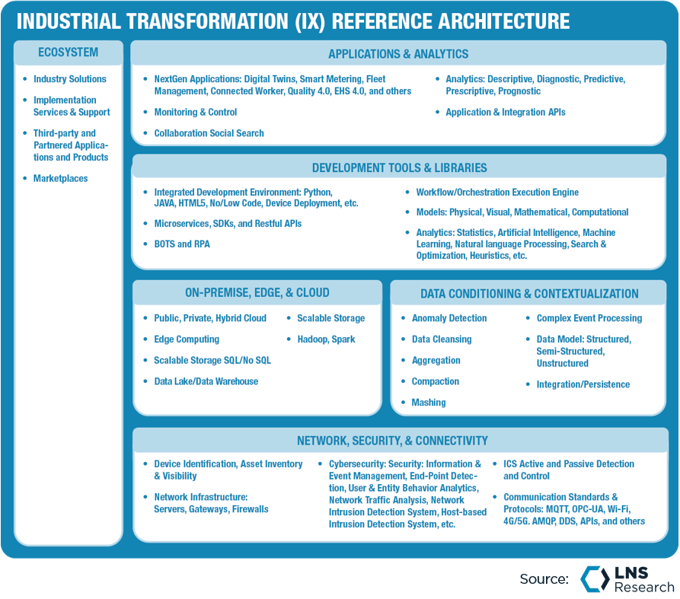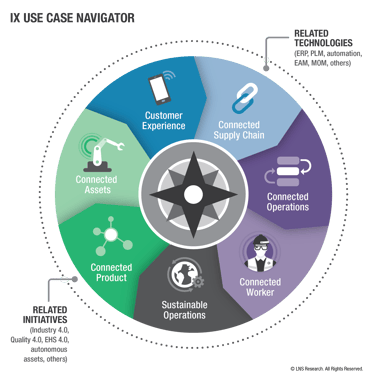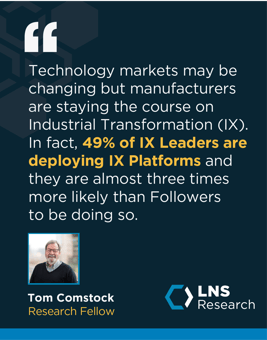Evaluating Potential Industrial Transformation (IX) Strategic Partners
Revisit our definition of IX Strategic Partners, the criteria used to evaluate vendors, and the list of vendors as we ready our next Solution...
A little over a year ago we published our Solution Selection Matrix (SSM) for IX Platforms. When we introduced the definition of the IX Platform, we noted that “…the ability to monitor markets, readjust IX Program initiatives and otherwise be adaptive to change is critical to achieving step change improvements in operations.” Here we seek to help manufacturers “monitor” the IX Platform market by highlighting five trends we see across the market. While we will cite some vendors as examples of the trends, we will provide more specific insight on a subset of those vendors over the next few months. Let’s revisit the definition of IX Platform and then highlight those trends.
LNS Research defines an IX Platform as:
A Platform as a Service (PaaS) that includes a broad set of reference architecture capabilities that can run on private or public cloud instances, support hybrid cloud architectures, includes advanced analytical capabilities like AI/ML, and provide a no-code/low-code app development environment and/or app store, for other third-party developers to offer applications across a broad set of the IX Use Cases, including but not limited to: operations, assets, products, supply chain, customer experience, and Connected Frontline Worker.
And we picture it below:

There are five trends racing across the IX Platform market.
It is never surprising to see vendors reposition within emerging markets. Any number of vendors have repositioned or fine-tuned their positioning since the finalization of the IX Platform Solution Selection Matrix (SSM).
Tulip was announcing their messaging around Frontline Operations just as we were going to press with the SSM. Facing the issue that many view “manufacturing” as solely the production activities in a plant, Tulip sought to envelope all the operations in a manufacturing plant including warehousing, material flow, logistics, quality, laboratory, and maintenance activities. Additionally, companies outside of the manufacturing industry are also finding value in Tulip supporting their frontline operations with connected apps. The company now positions Tulip as a “Frontline Operations Platform.” Tulip has been successfully deployed across all these types of activities, so the messaging reflects the realities of deployment.
C3 AI stock has been on a wild ride – as has much of the tech sector -- since we published the 2021 IX Platform SSM. The company has been in the business news for that wild ride. Their strategy and strategy execution has been much more linear. In 2021 we noted that “C3 AI is moving aggressively in the application domain with applications focused on connected assets, connected supply chain (inventory optimization), customer experience (CRM), and connected operations (sensor health and energy management) use cases.” The focus on applications has continued throughout 2022 resulting in continued revenue growth. We have seen C3 AI launch a number of new/enhanced applications including ESG, Reliability Suite, Supply Chain, and Manufacturing Data Engine (with Google). The company still promotes “Enterprise AI”, so a platform is core to their strategy, but their Go-to-Market message is increasingly about “pre-built” applications.
PTC is putting relatively less emphasis on Connected Product use cases (see Use Case section below) as they and the rest of the world realize that the conversion to the “servitization” of capital assets is a long-term trend, not an inflection point. While the company will continue to market and support Connected Products Use Cases, they are increasing the relative emphasis on Connected Operations (manufacturing and field services), Connected Frontline Workforce (particularly with Vuforia), and Connected Assets use cases. For example, PTC launched their Digital Performance Management solution in October 2021 and LNS Research believes this to be a core building block to the company’s long-term manufacturing strategy.
Rockwell Automation was not covered in the IX Platform SSM directly but through their partnership with PTC. Rockwell’s acquisition of Plex Systems, a company identified in the SSM as an “Emerging IX Platform Vendor” adds a new dimension to its place in the market. Plex offers a cloud-native smart manufacturing platform that offers fully integrated MES, ERP, and supply chain management (SCM). Additional low-/no-code process creation and automation functions account for why we view Plex as an IX Platform and leads to the question of Rockwell’s place/role in the IX Platform market over time.
 Ideally, vendors would stay in the boxes that analysts assign to them. But in search of revenue and valuation growth software vendors fail to follow the “rules” and are always pushing the boundaries of analyst categories. Nowhere is this truer than in the distinction between IX Platforms and IX Analytics vendors. Core to the distinction for LNS Research was the development environment of IX Platforms that should have the capability to build both monitoring (analytics) and control (execution) applications. A characteristic of this duality is exemplified by several vendors who use a data model as a Digital Twin, from which they deliver analytics insights across the manufacturing and supply chain. We included two such vendors in the IX Platform SSM: SightMachine and Tulip. However, we left out at least three who will be covered in the forthcoming IX Analytics SSM:
Ideally, vendors would stay in the boxes that analysts assign to them. But in search of revenue and valuation growth software vendors fail to follow the “rules” and are always pushing the boundaries of analyst categories. Nowhere is this truer than in the distinction between IX Platforms and IX Analytics vendors. Core to the distinction for LNS Research was the development environment of IX Platforms that should have the capability to build both monitoring (analytics) and control (execution) applications. A characteristic of this duality is exemplified by several vendors who use a data model as a Digital Twin, from which they deliver analytics insights across the manufacturing and supply chain. We included two such vendors in the IX Platform SSM: SightMachine and Tulip. However, we left out at least three who will be covered in the forthcoming IX Analytics SSM:
Braincube positions itself as offering an Industrial Internet of Things (IIoT) Platform, Digital Twins, and Industrial Analytics applications. While that aligns with our definition of an IX Platform and the company has had notable early market successes in IIoT, LNS Research views their product strengths, today, as fundamentally in Advanced Industrial Analytics as they focus on “Monitoring” rather than control/execution. The company’s website emphasizes those capabilities as their IIoT Platform is positioned as helping manufacturers become “more efficient with their data by collecting, integrating, and structuring both real-time and historical time-series data”. The company offers advanced analytics applications designed for manufacturers very much including Artificial Intelligence capabilities across many of those applications. In fact, they will very much be included in our forthcoming Solution Selection Matrix™ for Advanced Industrial Analytics. Braincube capabilities blur the line into IX Platforms with what they call “Digital Twins”, and we would call a comprehensive As-Built history with a heavy emphasis on “comprehensive”. Overall, they are leveraging a data model as a Digital Twin, from which they deliver analytics insights across manufacturing. LNS Research is tracking a number of manufacturers that are deploying Braincube across manufacturing as part of their Industrial Transformation program.
MachineMetrics markets the MachineMetrics Industrial IoT Platform for Machines and is right on the line between an IX Platform and IX Analytics. Their platform captures data from manufacturing equipment and offers cloud-based data visualization and analytics capabilities for use cases including Machine Monitoring, Condition Monitoring, Predictive Maintenance, and Process Optimization. The offering extends into the world of IX Platforms with integrations to provide real-time data to BI, ERP, MES, CMMS, and other systems as well as automated “workflow” capabilities. Those workflows enable machine data to automatically trigger a number of possible outcomes, such as data flow into other factory systems, inter-department communications, and operator actions throughout the shop floor – hence their inclusion here about the blurring lines between IX Analytics and IX Platforms.
Twin Thread was just coming out of stealth mode as we published our IX Platform SSM last year so was difficult to include. The company has now fully launched its offering as a “Predictive Operations Platform” focusing on delivering “Fleet Transformation” (“Connected Product use cases in LNS Research terms) and “Factory Transformation” (Connected Operations use cases to optimize plant and equipment efficiency) solutions. The company seeks to differentiate its offering by empowering domain experts, not just data scientists, to develop, apply, and tailor Artificial Intelligence (AI) and Machine Learning (ML) models to the wide range of equipment that are typical across a manufacturing network or fleet of assets. Fundamentally the company is seeking to deploy Digital Twin solutions and Advanced Industrial Analytics to help operations personnel improve performance. In fact, the company asserts that seven different models should be applied to an asset to produce a comprehensive Digital Twin. LNS Research is monitoring a number of companies that are actively rolling out TwinThread and will be watching closely these enterprise deployments for success. In addition, the company has executed “white label” agreements with two major automation companies which already appear to be contributing to sales growth. This maturation within their customer base and the potential of the channel/resale agreements with some of the biggest automation players will likely compel us to include them in the IX Platform SSM next year (in addition to the IX Analytics SSM this year.)
Collectively, these vendors are establishing a new category in this blurry space between control and monitoring…not a new form of MES, but instead a form of manufacturing performance analytics where the data model is the twin. Hence, they complement MES, or in some cases, substitute for MES. And in most cases, one can start out small, then scale to meet the needs of the factory, as opposed to buying an entire monolithic MES and then only implementing certain components.
All three will likely be included in the next version of the IX Platform SSM unless we elect to narrow the definition of an IX Platform to those that fully embrace monitoring/control capabilities in addition to monitoring.
LNS Research originally identified 35 IX use cases across six categories: Connected Products, Connected Assets, Connected Supply Chain, Connected Operations, Connected Workers, and Customer Experience. We noted that the history of IIoT and IX had been around Connected Products and quickly moved to Connected Assets, so those domains were the most mature. Over the last 12 months since we published the original report, we have seen two notable developments.

We are seeing some of the less mature sets of use cases blossom.
ThinkIQ has delivered meaningful insight and value into the Food and Beverage market by focusing on the Connected Supply Chain use cases. By having a detailed understanding of ingredients (components) across the supply chain, over time, ThinkIQ customers have been able to optimize their operations to improve product quality and efficiency. ThinkIQ’s efficiency and quality focus along with its Vision based sensoring can provide a true field-to-fork (supplier-to-customer) traceability.
Hitachi Vantara continues to show the value in Customer Experience use cases. Leveraging Lumada’s video analysis capabilities has delivered tangible benefits to retailers and cities.
Second, LNS Research has added a seventh category to our Use Case Navigator: Sustainable Operations. We are seeing more and more industrial companies linking their Sustainability strategies to and around their transformation strategies. Fundamental to the use cases is to operationalize the Sustainability goals being set by corporate executives. Our research shows that IX Leaders – those companies that have already gotten more tangible value from their IX investments – are three times more likely to deeply integrate their Sustainability and IX initiatives.
In his 2022 Predictions Blog, our compatriot Peter Bussey made two key predictions directly relevant:
Companies will heed that the Future of Industrial Work centers on people, not machines.
Individual vendors will build out their solution footprints to create expanded offerings through native development efforts, pre-configured solutions, and embedding third-party solutions. Examples of what we expect to see are vendors extending Connected Frontline Workforce solutions with new functionality such as Digital Work Instructions, Augmented Reality, Remote Assistance, Advanced Analytics, and pre-configured use cases and industry-specific solutions. For example, Dassault Systèmes Delmia has pivoted forcefully around “Sustainable Operations” and we expect to see many others embrace the message and the focus.
In my 2022 Predictions blog, I noted that: “We also expect to see significant continued innovation by all the Hyperscalers…Other software and automation companies are going to find it increasingly difficult to compete and will need to differentiate by their capabilities as an Industrial Data Hub or Advanced Industrial Analytics supplier.” In the Predictions blog, Amazon Web Services (AWS) was singled out but the other Hyperscalers are innovating rapidly as well. Microsoft has long served manufacturers and Google has recently re-entered the fray with Google Cloud for manufacturing.
The pace of innovation by the Hyperscalers, funded by cross-industry and consumer initiatives, is unmatchable by pure-play software companies and even large industrial companies. AWS was the first to strike with integrated packaging in the form of AWS for Industrial extending AWS IoT SiteWise to the Edge with SiteWise Edge and adding industrial machine learning (ML) services such as Amazon Monitron, Amazon Lookout for Equipment, Amazon Lookout for Vision, and AWS IoT TwinMaker for building Digital Twins. We have written about Amazon’s move up the OT stack. The question is how far they will continue to move up the manufacturing and supply chain stack.

Amazon is presenting a powerful challenge to Microsoft in manufacturing. For more than a decade Microsoft has been the clear technology of choice in manufacturing. In fact, many joke that MES stands for Manufacturing Excel Solutions given Microsoft’s pervasiveness. That pervasiveness has been built by a hugely successful partnering strategy. The company had tight relationships with most automation and manufacturing software companies. In fact, it is startling the number of manufacturing software vendors that believe they have a unique relationship with Microsoft given how many partners Microsoft has across manufacturing. Microsoft has a strong track record of innovation in IX technologies for manufacturers with Azure Digital Twins, Axure IoT Hub, IoT Central, and a myriad of other key technologies. Amazon going deeper into the plant may push Microsoft to “go up stack” as well, leading to more conflict with its powerful partner network. LNS Research will be watching the competition carefully, but we know that both Hyperscalers will increasingly challenge the IX Platform solutions from automation and manufacturing software companies.
Technology markets may be changing but manufacturers are staying the course on IX. More companies are executing or planning to execute an IX Program. They are staying the course through the pandemic. Additionally, more companies are succeeding at IX. We even had to redefine IX Leaders. IX Platforms continue and will continue to be correlated to IX Leadership: 49% of IX Leaders are deploying IX Platforms and are almost three times more likely than followers to be doing so.
Change is the only constant. In business and in technology. We stand by our earlier recommendation:
“IX is a mega, long-term trend with significant changes in scope and direction over time. Vendor capabilities will grow and morph over time as well. The winners in IX will be those that can implement IX initiatives in the near term while understanding that a change in direction/vendors may be required over time. Therefore, the ability to monitor markets, readjust IX Program initiatives and otherwise be adaptive to change is critical to achieving step change improvements in operations.”
So, stay tuned to LNS Research for the latest on these rapidly changing markets and more specific updates on some of these vendors!
All entries in this Industrial Transformation blog represent the opinions of the authors based on their industry experience and their view of the information collected using the methods described in our Research Integrity. All product and company names are trademarks™ or registered® trademarks of their respective holders. Use of them does not imply any affiliation with or endorsement by them.
As a member-level partner of LNS Research, you will receive our expert and proven Advisory Services. These exclusive benefits give your team:
Let us help you with key decisions based on our solid research methodology and vast industrial experience.
BOOK A STRATEGY CALLSiemens Acquires Camstar: Better Realizing Innovation for 3 Vertical Industries
Five Ways Industrial AI is Shaking Up Manufacturing (and Who’s Doing It)
The Definitive Guide to Manufacturing Acronyms
What Is Industrial DataOps & Why Does Every Manufacturer Need It?
Software-Defined Automation: Surprise... It's Not About Cost Savings
Revisit our definition of IX Strategic Partners, the criteria used to evaluate vendors, and the list of vendors as we ready our next Solution...
The LNS Research Solution Selection Matrix and Vendor Compendium evaluate vendors within the IX Platform ecosystem to create a shortlist of...
Vendor selection should be the last step of a Digital Transformation initiative, not the starting point. We've identified common mistakes companies...
The Industrial Transformation and Operational Excellence Blog is an informal environment for our analysts to share thoughts and insights on a range of technology and business topics.